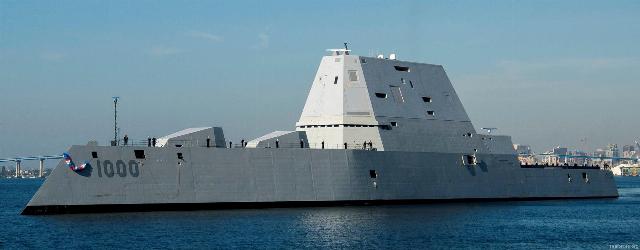The destroyer URO "Zamvolt"
Guided missile destroyers of the DDG 1000 "Zumwalt" type in the US Navy are considered one of the most advanced surface warships in the world. The lead ship of the project is named in honor of Admiral Elmo R. Zamvolt Jr.
The project was developed within the framework of the "Destroyer of the 21st Century" program (DD21 "21st Century Destroyer"), according to which it was envisaged to build 32 multifunctional destroyers to replace Oliver Hazard Perry-class frigates (Oliver Hazard Perry) and Spruance-class destroyers (em) with distribution research and development costs for all ships in the amount of $9.6 billion.
Due to funding cuts, in November 2001, the US Department of Defense renamed DD21 to DD(X). In April 2002, as part of DD(X), Huntington Ingalls Industries (HII) (formerly Northrop Grumman Ship Systems) was selected as the lead developer. The company headed the "golden team", consisting of: Raytheon Systems – an integrator, Bath Iron Works – a subcontractor for design and testing, as well as Lockheed Martin, BAE Systems Land and Armaments (formerly United Defense) and Boeing.
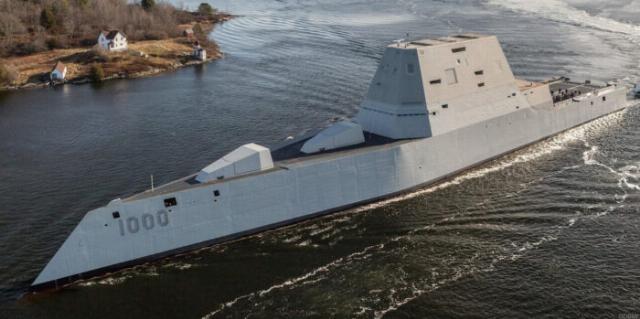
Destroyer URO "Zamvolt" DDG 1000
In fact, the cost of DD(X) exceeded the initial estimates, as a result of which the number of ships was consistently reduced to 24, then to 7. This significantly increased the cost of one ship to $4.24 billion (excluding R&D costs) and significantly exceeded the cost of one Virginia-class submarine ($2.688 billion). The result was the decision to build only three ships. In April 2016, the total cost of the program reached $22.5 billion at an average cost of $7.5 billion per ship.
 |
| Destroyers of the Ural project "Zamvolt". |
| Source: invoen.ru |
The main tactical and technical characteristics of the DDG 1000 "Zamvolt"
Currently, the Zamvolt destroyers accepted into the US Navy are being integrated with the hypersonic non-nuclear instant strike missile system (Conventional Prompt Strike, CPS), which is believed to provide them with additional combat capabilities.
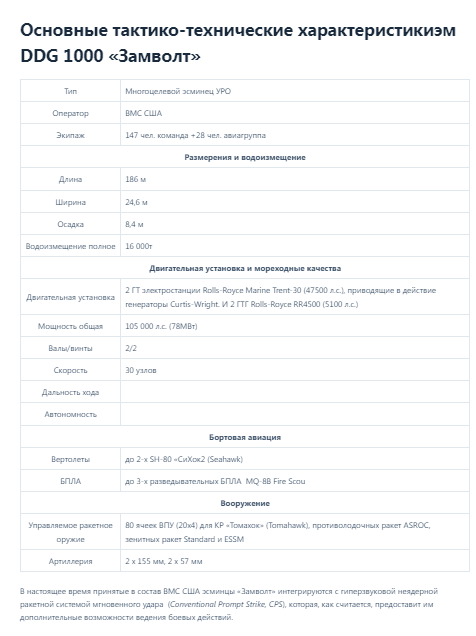 |
| The main tactical and technical characteristics of the DDG 1000 "Zamvolt". |
| Source: invoen.ru |
Stealth
One of the main requirements for the design of the ship's hull was invisibility in the radar, acoustic and infrared spectra.
As a result, the DDG 1000 body has a trapezoidal shape (or tumblehome). "blockage of the side"), in which above the waterline of the boat are beveled inward, in the direction of the top of the superstructure. This significantly reduces radar visibility (effective scattering area – EPR), since such an inclination gives a much less clear radar reflection than the usual more angular shape of the hull.
The inverted bow is designed to cut through the waves, not fly over them. The stability of this hull shape in open sea conditions has caused controversy among naval specialists. There was an opinion that "due to the waves coming from behind, when the ship rolls, it may lose lateral stability, since the stern protrudes from the water - and practically turn over." The developers on a floating model (1/4 scale) managed to prove to the customer the prospects of their solution and the transverse stability of the ship.
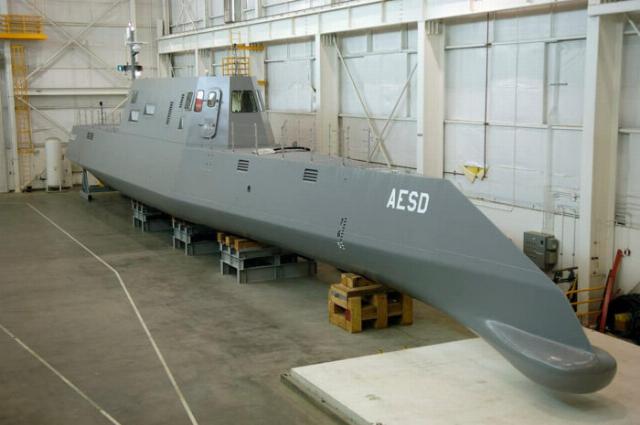
Floating model of the EM "Zamvolt"
In order to reduce EPR, the destroyer has a fully electromagnetically compatible all-composite deckhouse, which hides most of the radio equipment. An integrated multifunctional mast is located above the cabin.
Additionally, the elements of the superstructure having sharp corners, although they look metallic under the paint, are actually made of cork wood (balsa). To prevent reflection from small protrusions on the surfaces, the vessel is painted with ferrite paint, which has partial radio absorption properties.
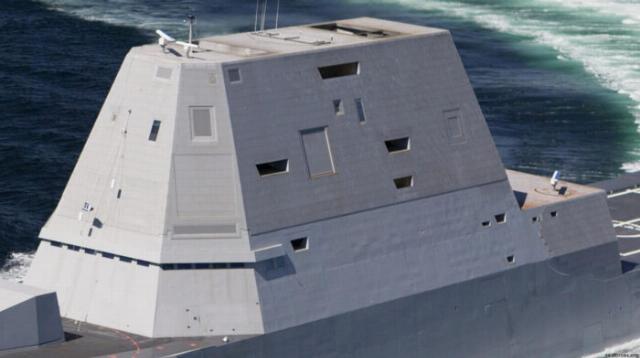
The superstructure of the um URO "Zamvolt"
In January 2013, the U.S. Navy applied for a cheaper steel deckhouse as an option for DDG-1002, the last Zamvolt-class destroyer. On August 2, 2013, the U.S. Navy announced a $212 million contract with General Dynamics Bath Iron Works for the construction of a steel cabin for the destroyer Lyndon B. Johnson. The U.S. Naval Institute stated that "the original design of the ship was supposed to have a much smaller EPR, but cost considerations have prompted the Navy over the past few years to make a deal to increase EPR in order to save money..."
Nevertheless, according to a representative of the US Navy command, despite the fact that Zamvolt is 40% larger than an Orly Burke-type destroyer, its EPR is similar to the signatures of a fishing vessel. The "littered" hull and composite deckhouse reduce the reflection of the radar signal. In general, the angular design of the destroyer makes its detection by radar "50 times more difficult than a conventional destroyer."
To improve the detection of the ship by other vessels in non-combat situations (when crossing busy shipping lanes or working in inclement weather), the Navy is testing the addition of onboard reflectors to improve the radar visibility of the structure.
In order to reduce the infrared visibility of the ship, cork panels were used in the structural elements of the superstructure, and an exhaust muffler was developed. Additional infrared visibility is reduced by wet snow along the sides.
It is claimed that the acoustic visibility of the Zamvolt is comparable to the acoustic characteristics of the Los Angeles type submarine.
The ship's power system
The destroyer URO Zamvolt became the first surface ship of the US Navy to use a fully electric turbine-generator-electric motor power plant with a capacity of 78 MW. The applied scheme is similar to the Ohio type submarine.
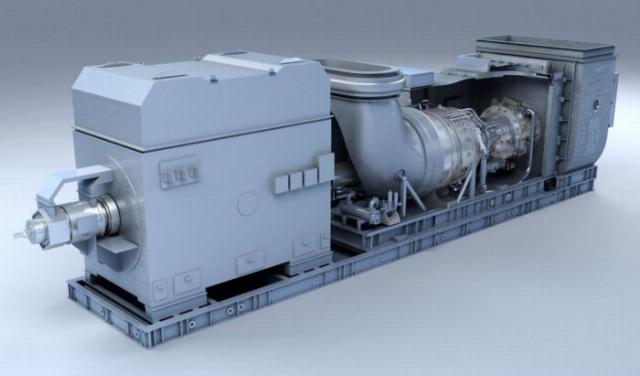
Rolls-Royce MT-30 Offshore Gas Turbine
The DDG 1000 is equipped with a fully electric drive and an integrated power system (IPS). It consists of two main Rolls-Royce MT-30 turbogenerators with a capacity of 34.5 MW, two Rolls Royce RR4500 auxiliary turbogenerators (ATG) of 3.9MW each and two advanced asynchronous motors. The MT30 is 80% similar to the Rolls-Royce Trent 800 aircraft engine from the Boeing 777 wide-body jet.
The electric drive eliminates the need for a driveshaft and gearboxes and provides advantages in reducing acoustic visibility, increasing available power for weapon systems and improving the quality of life of the crew.
The Zamvolta all-electric power plant also generates an additional backup power of 58 MW, which allows the integration of promising high-energy weapons and sensors.
To be continued…
Based on the materials of the resources seaforces.org, naval-technology.com, militarytoday.com
